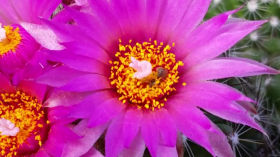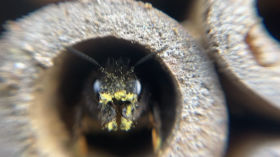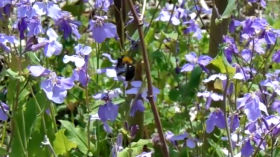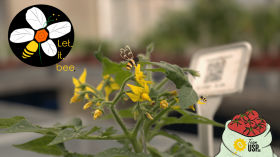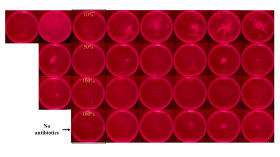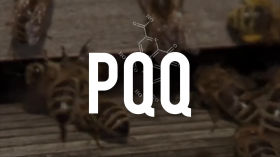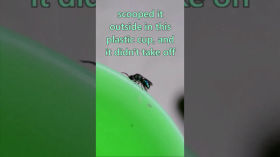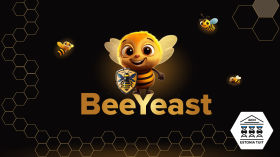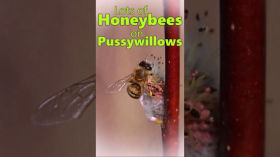230 videos
A sweat bee takes a "pollen bath."
A sweat bee visits a Pincushion Cactus flower in Manitoba, Canada. Recorded June 7, 2018.
Japanese Carpenter Bee Pollinating Sweet Violets
A Japanese Carpenter Bee (Xylocopa appendiculata) is pollinating Sweet Violets (Viola odorata) on April 15th 2024
USP-Brazil: Let.it.bee. (2021) - Team Presentation [English]
Title: Let.it.bee.
Description: Bees are very important for the environment and economy since they are responsible for the pollination of about 70% of crops worldwide. Some crops are completely dependent on bee pollination to exist. Since the 1990s, registers show a decrease in bee s populations, associated with multifactorial causes, such as the Colony Collapse Disorder and Acute Intoxication. One of the most worrying causes is the misuse of neonicotinoids pesticides, of which the most used is Imidacloprid. Bees when in contact with contaminated pollen take it to the colony, spreading the toxicity and causing mass deaths. To address this we developed a plant (Solanum lycopersicum) that can metabolize Imidacloprid specifically in pollen. We associated a pollen specific promoter, pLAT52, to the expression of the enzyme CYP6G1, responsible for metabolizing Imidacloprid in the pesticide resistant Drosophila melanogaster. This way pollen remains safe for pollinators while the rest of the plant is protected against pests.
NCHU-Taichung: Reviving Pollination: The PQQ lighting up Bee's Dilemma. (2023) - Team Presentation [English]
Title: Reviving Pollination: The PQQ lighting up Bee's Dilemma.
Description: This project aims to investigate the impact of PQQ on bees in hopes of improving the current pollination crisis. PQQ, a highly valuable antioxidant, has been shown in previous research to enhance mitochondrial biogenesis, metabolic rate, and memory. However, feeding such an expensive compound to insects is impractical. In this iGEM project, we have introduced PQQ biosynthetic pathway into Bacillus subtilis natto. We then fed the supernatant to our model honeybees, Apis mellifera. In brief, we used electroporation to transform the plasmid and treated the bees with the supernatant. For the bees, we adopted a buffet-style feeding approach on the first day with PQQ, followed by continuous monitoring of the bees subsequently. The results revealed that the effects of PQQ on bees disappeared by the third day post-feeding but could be restored through refeeding. Furthermore, the experiments showed that PQQ significantly improved the flight capabilities and memory of the bees.
NCHU-Taichung: Reviving Pollination: The PQQ lighting up Bee's Dilemma. (2023) - Project Promotion [English]
Title: Reviving Pollination: The PQQ lighting up Bee's Dilemma.
Description: There are numerous environmental stresses that pose a threat to the bees.
This may result in pollination crisis. In our project, we propose a promising
supplement for bees to improve bees' flight endurance and cognitive ability. Consequently, it enhances their resistance to environmental stress. At last, we aim to alleviate the pollination crisis. Create a sustainable environment and a promising future with the effort of NCHU_Taichung iGEM Team.
Dazzling Green Tiny Native Bee
Pearly (cat) let herself back into the house last week, leaving the screen door open. Later I found this adorable itsy bitsy bee on the washing machine. I got it to go into this plastic cup, and carried it outside. Surprisingly, it wasn't in a hur...
Estonia-TUIT: BeeYeast: Yeast Engineering to Fight Bee Viral Infections (2023) - Team Presentation [English]
Title: BeeYeast: Yeast Engineering to Fight Bee Viral Infections
Description: Honey bees play a crucial role as pollinators that is essential for preserving biodiversity. They also yield valuable products such as honey and beeswax, integral to human livelihoods. Unfortunately, honey bee populations are globally declining, influenced by factors like pathogens, climate shifts, and excessive pesticide use. Among these challenges, the Deformed wing virus (DWV), primarily transmitted by mites, is particularly widespread and detrimental, causing the death of millions of bees annually. The Estonia-TUIT team aims to suppress viral protein expression within bee cells by inducing RNA interference response. Our strategy involves genetically modified yeast cells producing short hairpin RNAs, which inhibit DWV gene expression. To deliver these shRNAs into bee cells, we intend to either feed our modified yeast to bees or directly inject shRNA-containing extracts into honeycombs. This approach aims to boost the bee's inherent RNA interference immune response, protecting them from the virus's harmful effects.
Itsy Bitsy Bees on Spring Flowers + Honeybees on Pussywillows #pollinators #nature #Alberta
April 23. Flowers are popping up in the rock gardens, and the native bees are ready! These tiny ones are the first species I've seen for the year. Meanwhile, on the wild willows, more honeybees. I think I spotted another native bee out there but...


